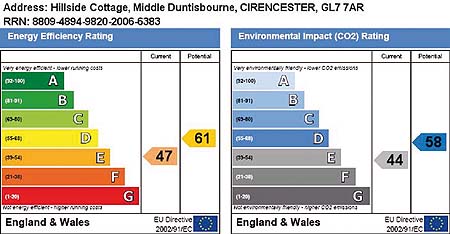Energy rating for rural properties

To date, the majority of residential and commercial properties on farms and estates have been exempt from the requirement to produce Home Information Packs (HIPs) and Energy Performance Certificates (ECPs), as commercial properties, houses with land, mixed sales and let properties were specifically excluded from the HIP legislation.
But under the 2003 Energy Performance of Buildings Directive (EPBD), as of 1 October, the vast majority of rural properties will require EPCs either as part of a HIP or now as a standalone document, upon sale or rental.
An EPC considers how a property, and its hot water supply, is heated, how this heat is stored and controlled. The certificate provides an energy rating for each property, banded on a scale of A-G, with Band A being the most efficient. This is displayed as a graph, similar to those found on white goods. Most residential properties in the UK to date have a band D-E rating.
Since the introduction of HIPs purchasers have started to give greater consideration to the cost of heating properties and general energy efficiency. It is felt that this change in attitude is likely to increase as EPCs become a factor in both the commercial and residential rental sectors, where a wider choice of different properties allows occupiers to consider energy costs to a far greater extent.
As with the initial confusion on the introduction of HIPs, many rural residential and commercial property owners remain unsure of what is required.
In summary, with regard to farms and estates, the regulations are as follows:
- Upon sale, almost all residential properties, whether tenanted or not, will require an EPC to be available to the purchaser.
- If the property is to be sold in lots then any residential property in a separate lot may still require a HIP, including an EPC.
- Upon sale, most commercial or “non-domestic” properties, whether tenanted or not, will require an EPC to be available to the purchaser.
- With regard to the letting of both residential and commercial property the legislation requires the landlord of most property publicly marketed for rent after the 1 October, to provide an EPC to a prospective tenant.
- There are exemptions for commercial buildings of less than 50sq m and those with low energy demand, eg an unheated barn. The rules for the definition of “low energy demand” are quite complex and legal advice on this may be prudent.
- While only full implementation of the legislation should answer all questions in respect of specific matters, it is felt that a heated part of an otherwise unheated building, such as a tack room or lambing accommodation quarters, will require a certificate as well.
- Holiday cottages, under a restricted occupation planning consent, and properties where rooms are let on a B&B basis or to a lodger, will not require an EPC.
- Most EPCs are valid for 10 years, and there is no need to renew them if changes are made to the property.
- If a new tenancy or lease is drafted with an existing tenant, and as long as the property has not been marketed, an EPC is not required.
- As of the 9 September 2008 amendment to the legislation, properties classified as “non-domestic”, that have been on the market before 1 October and remain unsold, will need an EPC by 1 January 2009 at the latest. If such a property is sold or rented out in the meantime, an EPC must be commissioned and then handed over to the potential purchaser or tenant as soon as practicable.
- Currently you can expect to pay between £70 and £120 for a standalone EPC on a residential property, depending on its size. In respect of commercial energy certificates most companies are quoting between £250 and £500 for properties up to 1000sq ft, and then between 35p and 20p/sq ft for larger properties, dependant on the structure and layout of the building.
The penalty for breaching the regulations in respect of the sale or renting out of a dwelling is £200 for each breach. The penalty for breaching the regulations in respect of commercial buildings is variable depending on the rateable value of the property, subject to a minimum and maximum of £500 and £5000 for each breach.

| Name | Type and size | Date current tenancy ends | EPC requirement |
| Keepers cottage | Three bedroom house let on six month ASTs | 10 September 2008 | Property will require an EPC as at 1 October 2008 |
| Grove cottage | Four bedroom holiday cottage (restricted occupancy) let on a weekly basis | n/a | No EPC required |
| The Old Stables (converted offices) | Commercial offices let on a business lease 90sq m | 10 December 2008 | An EPC will be required for prospective purchasers |
| Top Field Barns | Set of open-sided barns let to neighbour for hay/straw storage | n/a | No EPC required as deemed low energy demand building |
Sam Parkes is a rural chartered surveyor and energy assessor and lectures at the Royal Agricultural College, Cirencester. 01285 652 531 or sam.parkes@rac.ac.uk
Return to Property special homepage
